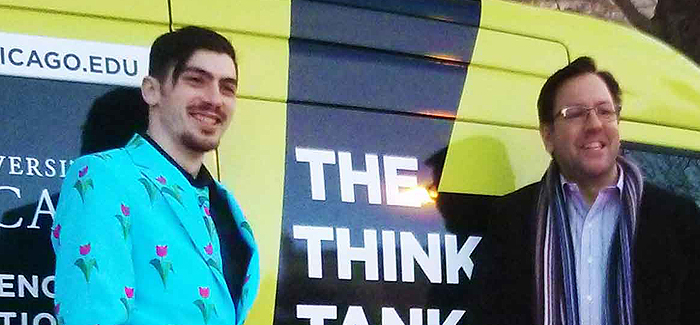
Think Tank cofounders Tyler Alterman (left) and Daniel Casasanto bring neuroscience to schoolchildren. (Photography by Stephanie Bi, ’16)
Two UChicagoans bring diversity to science and engineering, with the help of a bright green truck.
In his classes, psychology professor Daniel Casasanto likes to ask students to name famous female or nonwhite scientists. Beyond Marie Curie or Neil deGrasse Tyson, they don’t come up with many names. “There’s a problem here,” he says. While the lack of women and nonwhites in science, math, and technology fields is not a new problem, Casasanto sees it as a self-perpetuating one. “We need eminent scientists from these underrepresented minorities,” he says, “so that students like them can look up and think, ‘If that person can be in the pantheon of great scientists, then maybe I can be too.’”
This is the rationale behind the Think Tank, a fledgling project that aims to introduce science and engineering fields to female and minority students. With the aid of a bright green truck, the Think Tank will drive to Chicago-area high schools to engage students in the nuts and bolts of neuroscience and foster curiosity for research.
Tyler Alterman, Think Tank cofounder and codirector, credits his mother for the truck idea—she suggested that he build a mobile lab dedicated to neuroscience. “I realized that the idea was kind of brilliant,” Alterman says, “because the advantage of putting science education in something on wheels is that you can bring it to the places that need it most.”
Alterman and Casasanto see a disconnect between how science is presented in schools and how it’s practiced. “Science is too often taught as a catalog of facts to be memorized,” says Casasanto, who joined the University this past summer. “But there’s no right answer to be memorized, only sets of questions to try to understand. It’s the scientist’s challenge to develop ways of answering these questions.” Alterman’s motivation is more personal. “All throughout high school, I hated science,” he says. It was only after he had begun to conduct psychology research in Casasanto’s lab as a senior in CUNY’s Macaulay Honors College that he realized that research was very different from the rote memorization he was taught in school. Spurred by this discovery, he began working on the Think Tank as his senior thesis.
The team has spent the past several months developing a curriculum for the Think Tank’s visits to local Chicago schools, which they debuted in February at the UChicago Woodlawn Charter campus. “I think we got exactly the kind of reaction with our curriculum that we’d hoped,” Alterman says of the Woodlawn visit. “Neuroscience is about the electrical and chemical systems which make us people, and people are naturally interested in people.”
Along with the NEURO club, an undergraduate neuroscience outreach group, Casasanto and Alterman plan to introduce high school sophomores and juniors to the scientific process through four-week-long programs. As part of their discussions, they’ll delve into the academic back-and-forths that produced seminal theories such as plate tectonics. The Think Tank will also offer an internship spanning two summers, in which high schoolers will conduct research in UChicago labs under the guidance of PhD students and neuroscientists.
The two also want to extend scientific awareness beyond the classroom, and they’re convinced that the study of the brain is the way to do it. “You might be able to say, ‘I’m not interested in how the liver works,’ but it’s impossible to say, ‘I’m not interested in how the mind works,’” Casasanto says. Cognitive science is what Casasanto calls a “hub” discipline: it joins researchers working in fields as disparate as engineering and anthropology. “Once you start asking questions about how brains and minds work,” he says, “you are suddenly in contact with people who ask similar questions in very different ways.” The two plan to take the Think Tank to festivals, museums, and large public events to get the general public excited about our current understanding of the brain. Recently, at a conference for the American Association for the Advancement of Science, they used brainwave-reading headsets to give interested onlookers visual and auditory images of their mental relaxation levels.
The project got its start in New York, where both Alterman and Casasanto were based. They had originally conceived of the Think Tank simply as a tool to collect neurological data and increase scientific awareness. But when Casasanto and the project relocated to Chicago, they realized—seeing the work of similar University efforts, from the Urban Education Institute to UChicago Promise— that the Think Tank could better be used to help promising students from underrepresented backgrounds. “We’re getting a ton of institutional support and connections to all the civic outreach that UChicago is doing,” Alterman says. “It was an offer I couldn’t refuse.”
Video
A look at how Think Tank hopes to accelerate diversity in the sciences.
